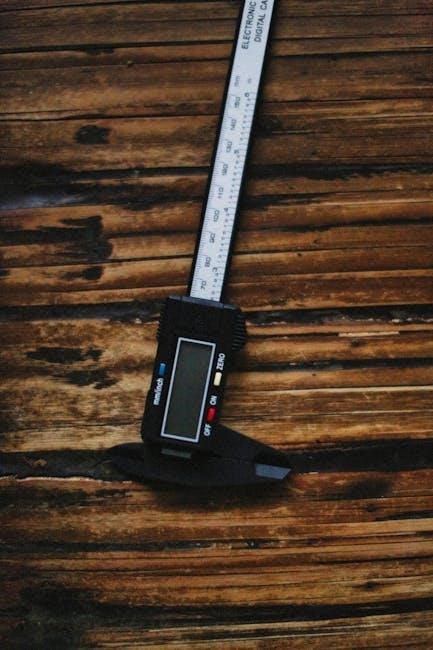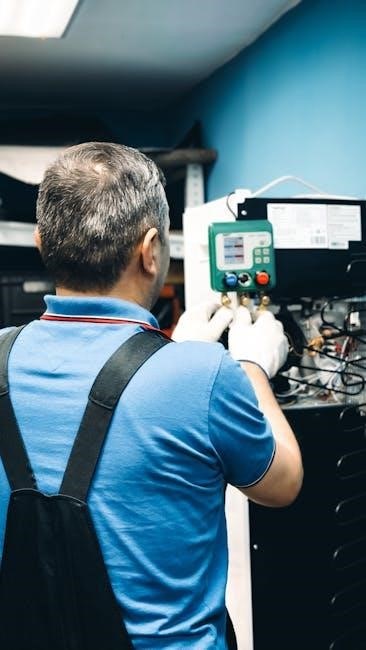An extension cord gauge guide helps users understand wire thickness and safety ratings, ensuring efficient power delivery while preventing hazards. This guide provides essential insights for safe and effective use.
1.1 What is an Extension Cord Gauge?
An extension cord gauge refers to the thickness of the wire inside the cord, measured using the American Wire Gauge (AWG) system. A lower gauge number indicates a thicker wire, capable of handling more electrical current safely. Understanding the gauge is crucial for ensuring the cord can support the power requirements of connected devices without risking overloading or overheating. This measurement directly impacts both safety and efficiency when using extension cords for various applications.
1.2 Importance of Understanding Wire Gauge
Understanding wire gauge is essential for ensuring safety and efficiency when using extension cords. The gauge determines the cord’s current-carrying capacity, directly impacting its ability to power devices without overheating. Incorrectly matched gauges can lead to fire hazards, damaged equipment, or electrical failures. By selecting the right gauge, users can prevent overloading, maintain optimal performance, and extend the lifespan of both the cord and connected devices. This knowledge is vital for safe and reliable electrical connections in various settings.

What is AWG (American Wire Gauge)?
The American Wire Gauge (AWG) is a standard for measuring wire diameters. Lower gauge numbers indicate thicker wires with higher current-carrying capacity, crucial for safe electrical connections.
2.1 Definition and Basics of AWG
The American Wire Gauge (AWG) system defines wire thickness by a numerical scale. Lower gauges mean thicker wires capable of handling higher currents, while higher gauges are thinner for lighter use. AWG is standardized, ensuring consistency across materials and applications, from electrical wiring to extension cords. This system helps users match the right wire size to their power needs, optimizing safety and efficiency in various electrical setups and devices. Proper understanding of AWG is essential for avoiding hazards and ensuring reliability.
2.2 How AWG Relates to Extension Cords
AWG directly impacts an extension cord’s current capacity and safety. Thicker wires (lower AWG) handle more current, reducing heat buildup and voltage drop over longer distances; For extension cords, choosing the correct AWG ensures safe power delivery, preventing overheating and potential fire hazards. Higher AWG (thinner wires) are suitable for low-power, short-distance uses, while lower AWG (thicker wires) are ideal for high-power devices or longer cords, maintaining efficiency and reliability in various applications.

How to Choose the Right Extension Cord Gauge
Selecting the right gauge involves considering your device’s power needs, the cord’s length, and its intended use to ensure safe and efficient energy transfer.
3.1 Understanding Your Device’s Power Requirements
Understanding your device’s power requirements is crucial for selecting the right extension cord. Always check the device’s voltage and amperage ratings to ensure the cord can handle the load. Higher power devices like refrigerators or power tools require thicker, lower gauge cords to prevent overheating. Using a cord with too thin a gauge can lead to safety hazards. Refer to the device’s manual for specific power needs and match it with the appropriate extension cord gauge. This ensures safe and efficient operation.
3.2 Matching Gauge to Device Amperage
Matching the extension cord’s gauge to your device’s amperage ensures safe and efficient power delivery. Lower gauge numbers indicate thicker wires capable of handling higher currents. For example, a 14 AWG cord is suitable for up to 15 amps, while a 12 AWG cord can handle higher loads. Always check the device’s amperage rating and choose a cord with a gauge that can accommodate it. Mismatching can lead to overheating, damage, or safety hazards. Proper matching ensures reliable performance and longevity of both the cord and device.
3.3 Considering the Length of the Extension Cord
Extension cord length impacts its ability to deliver power safely. Longer cords increase resistance, potentially causing voltage drop and overheating. For longer cords, a lower gauge (thicker wire) is needed to maintain efficiency and prevent hazards. For example, a 25-50 foot cord may require a 12 AWG for high-amperage devices, while shorter cords (under 25 feet) can use a 14 AWG. Always balance length and gauge to ensure safe, reliable power delivery to your devices.
3.4 Indoor vs. Outdoor Use
Indoor and outdoor extension cords differ in design and durability. Outdoor cords are built to withstand harsh weather, moisture, and temperature fluctuations, often featuring thicker insulation and higher safety ratings. Indoor cords are lighter, with lower gauges (e.g., 16-18 AWG) suitable for shorter distances and lower power needs. Always choose cords rated for their intended environment to ensure safety and efficiency.Outdoor cords typically require heavier gauges (e.g., 14 AWG) for longer lengths and heavier-duty applications.

Extension Cord Gauge and Safety
The right gauge ensures safe power delivery, preventing overheating and fire hazards. Always check ratings for amperage and length to avoid risks and maintain electrical safety.
4.1 Risks of Using the Wrong Gauge
Using the wrong extension cord gauge can lead to overheating, a serious fire hazard. It may also damage connected devices and cause electrical failures. To avoid these risks, always match the gauge to your device’s amperage needs and opt for shorter cords when possible. This ensures safe and reliable power delivery.
4.2 How Gauge Affects Heat and Fire Hazards
A lower gauge extension cord carries more current safely, reducing heat buildup. Using a higher gauge (thinner wire) for high-power devices can cause excessive heat, potentially leading to fires. Always choose the appropriate gauge for your device’s amperage to prevent overheating and ensure safe operation.
4.3 Safety Certifications to Look For
When selecting an extension cord, look for safety certifications like UL (Underwriters Laboratories) or ETL (Intertek) labels. These ensure the cord meets safety standards for heat resistance and electrical performance. Such certifications indicate the product has passed rigorous testing, reducing fire hazards and ensuring reliability. Always prioritize cords with recognized safety labels to maintain electrical safety and avoid potential risks associated with non-compliant products.
Common Extension Cord Gauges and Their Uses
Extension cords are available in various gauges, such as 14 AWG, 12 AWG, 10 AWG, and 8 AWG, each suited for different power requirements and applications.
5.1 14 AWG: Typical Uses and Limits
A 14 AWG extension cord is suitable for lighter-duty applications, such as powering small appliances, lamps, or tools requiring up to 15 amps. It is ideal for short distances, typically up to 25 feet, to maintain safe and efficient performance. While versatile, it is not recommended for high-current devices or longer lengths, as it may overheat or cause voltage drop. For heavier loads or extended use, a lower gauge, like 12 AWG, is more appropriate. Always match the cord’s capacity to the device’s requirements for safety and efficiency.
5.2 12 AWG: Heavy-Duty Applications
A 12 AWG extension cord is designed for heavy-duty tasks, such as powering high-current tools, heavy machinery, and large appliances. Its thicker wire withstands higher amperage, making it ideal for workshops, construction sites, and outdoor use. It safely handles longer distances with minimal voltage drop, ensuring reliable performance. Compared to 14 AWG, it offers greater durability and current capacity, making it the preferred choice for demanding applications where power and safety are critical. Always select 12 AWG for tools requiring 16-20 amps to prevent overheating and ensure efficiency.
5.3 10 AWG and 8 AWG: High-Current Needs
10 AWG and 8 AWG extension cords are designed for high-current applications, such as industrial machinery, large generators, and heavy-duty power tools. These thicker gauges minimize resistance, allowing for safe and efficient power delivery over long distances. 10 AWG handles up to 20-30 amps, while 8 AWG supports 30-40 amps, making them ideal for professional and industrial settings where heavy power demands are common. They are essential for applications requiring high reliability and minimal voltage drop, ensuring optimal performance in demanding environments. Always use these gauges for equipment with high amperage requirements to maintain safety and efficiency.
5.4 16 AWG and 18 AWG: Lightweight Options
16 AWG and 18 AWG extension cords are lightweight and ideal for smaller, low-current applications. 16 AWG cords are suitable for devices requiring up to 13 amps, while 18 AWG cords handle up to 10 amps. These gauges are perfect for indoor use with lamps, small electronics, and chargers. Their thinner design makes them portable and easy to manage. However, they are not recommended for high-power tools or long-distance use, as they may overheat. These cords are great for everyday household needs where minimal power is required.

Extension Cord Gauge Chart
An extension cord gauge chart compares AWG ratings with amperage and maximum cord lengths, helping users select the right cord for their power needs safely.
6.1 AWG vs. Amperage Ratings
The AWG (American Wire Gauge) system directly relates to a cord’s amperage capacity. Thicker wires, like 10 AWG, handle higher currents (20-30 amps), while thinner ones, such as 14 AWG, support lower currents (15 amps). Understanding this relationship is crucial for safe usage, as exceeding the amperage rating can cause overheating and fire hazards. Always match the device’s amperage requirements with the extension cord’s AWG rating to ensure optimal performance and safety.
6.2 AWG vs. Cord Length Limits
A higher AWG number corresponds to thinner wires, which are less capable of handling current over long distances. For example, a 14 AWG cord is suitable for up to 25 feet, while a 12 AWG can safely extend up to 50 feet. Longer cords require thicker wires to minimize voltage drop and ensure safe operation. Always consult the AWG chart to match the cord’s gauge with its intended length to maintain efficiency and prevent potential hazards like overheating.
Tips for Using Extension Cords Safely
Always choose the correct gauge for your device, avoid overloading, and keep cords away from heat sources. Never use damaged cords and ensure proper storage to maintain safety.
7.1 Dos and Don’ts of Extension Cord Usage
- Do use heavy-duty cords for high-current or long-distance needs.
- Do check the cord’s amperage and gauge rating before use.
- Do keep cords away from heat sources and flammable materials.
- Do store cords properly to avoid damage and tangles.
- Don’t overload cords with devices exceeding their capacity.
- Don’t use damaged or frayed cords, as they pose fire risks.
- Don’t extend cords beyond their maximum rated length.
- Don’t place cords under rugs or tight spaces to avoid overheating.
- Don’t use indoor cords outdoors or vice versa.
7.2 Avoiding Overloading
Avoiding overloading is crucial for safe extension cord use. Always match the cord’s amperage rating to your device’s power requirements. Exceeding the cord’s capacity can cause overheating, damage, or fire risks. Use heavy-duty cords for high-current devices and ensure the cord’s gauge is appropriate for the task. Never connect multiple high-power devices to a single cord, and monitor for signs of overload, such as warm cords or flickering lights. Proper usage ensures safety and efficiency.
7.3 Proper Storage and Maintenance
Proper storage and maintenance of extension cords are essential for longevity and safety. Store cords in a dry, cool place, away from direct sunlight and moisture. Avoid kinking or tangling, as this can damage the internal wires. Regularly inspect cords for frays, cuts, or worn plugs, and replace damaged cords immediately. Never rewind a cord while it’s still warm, as this can cause permanent damage. For outdoor cords, ensure they are rated for outdoor use and protected from environmental hazards. Proper care extends the life of your extension cords and ensures safe operation.

How to Read Extension Cord Labels
Understanding extension cord labels is crucial for safe use. Look for gauge, length, and amperage ratings to ensure compatibility with your devices and needs.
8.1 Deciphering Gauge, Length, and Amperage
Extension cord labels display gauge (AWG), length (feet), and amperage ratings. Gauge indicates wire thickness—lower numbers mean thicker wires. Length affects voltage drop, while amperage shows the cord’s current capacity. Matching these specifications to your device ensures safe operation. For example, a 12 AWG cord handles higher currents than 14 AWG, making it suitable for heavy-duty appliances. Always check the label to ensure compatibility with your equipment’s power requirements and the task at hand.
8.2 Understanding Safety Ratings
Safety ratings on extension cords indicate compliance with industry standards, ensuring protection against overheating, electrical hazards, and environmental factors. Look for certifications like UL (Underwriters Laboratories) or ETL, which verify safety. These ratings also specify suitable environments, such as indoor or outdoor use. Higher-rated cords are designed for harsher conditions or heavier loads. Always check the safety ratings to ensure the cord meets your needs and adheres to safety guidelines, preventing potential fire or electrical risks.
Extension Cord Gauge for Specific Applications
Choosing the right gauge for specific tasks ensures safety and efficiency. Heavy-duty applications require lower gauges, while lighter tasks can use higher gauges, optimizing performance and reducing risks.
9;1 Workshop and Power Tools
For workshops and power tools, a lower gauge extension cord is essential to handle high amperage demands. A 12 AWG or 10 AWG cord is recommended to ensure safe and consistent power delivery. These gauges minimize voltage drop, preventing overheating and maintaining tool performance. Always match the cord’s amperage rating to your tool’s requirements to avoid damage or electrical hazards. Proper selection ensures reliability and safety in demanding environments.
9.2 Home Appliances
For home appliances, choosing the right extension cord gauge is crucial to ensure safe and efficient operation. A 14 AWG or 16 AWG cord is typically suitable for most household devices, such as lamps or small electronics. However, for higher amperage appliances like refrigerators or air conditioners, a lower gauge (12 AWG or 10 AWG) is recommended to handle the increased power demand. Always check the appliance’s manual for specific recommendations and ensure the cord length and gauge match the device’s requirements to prevent overheating and electrical hazards.
9.3 Outdoor and Heavy-Duty Use
For outdoor and heavy-duty applications, a thicker extension cord gauge is essential to handle higher power demands and longer distances. A 12 AWG or 10 AWG cord is ideal for heavy-duty tools, while 14 AWG is suitable for lighter outdoor tasks. Outdoor cords should be weather-resistant and durable, with proper ratings for moisture and temperature. Always ensure the cord is rated for the device’s amperage and length to avoid overheating. Prioritize safety by avoiding overloaded cords and checking for damage before use.

Frequently Asked Questions
Using the wrong gauge can cause overheating and fire hazards. Always match the cord’s rating to your device’s amperage and length for safe operation and efficiency.
10.1 What Happens if I Use the Wrong Gauge?
Using the wrong gauge can lead to dangerous overheating, fire hazards, and damaged equipment. A gauge too thin for the current may overheat, causing electrical fires or power loss. Conversely, a thicker gauge than needed wastes money and offers no benefits. Always match your device’s amperage to the cord’s rating for safety and efficiency.
10.2 Can I Use Multiple Extension Cords Together?
Using multiple extension cords together is possible but risky. It can lead to voltage drop, overheating, and fire hazards. Always ensure the combined load does not exceed the lowest-rated cord’s capacity. For safety, it’s best to use a single, appropriately gauged cord for your needs. If multiple cords are necessary, consult a professional to ensure safe and efficient connections.

Glossary of Terms
A collection of key definitions related to extension cords, including AWG, amperage, voltage, and gauge, helping users understand essential terminology for safe and efficient use.
11.1 Key Terms Related to Extension Cords
American Wire Gauge (AWG): Measures wire thickness. Lower AWG means thicker wire, higher current capacity. Amperage: Maximum current an extension cord can safely handle. Voltage: Electrical pressure. Gauge: Wire thickness, impacting current capacity. Safety Certifications: UL (Underwriters Laboratories) and ETL ensure compliance with safety standards. Cord Length: Longer cords increase voltage drop. Insulation: Protects wires from damage, essential for indoor/outdoor use. These terms are vital for selecting the right extension cord for safe and efficient power delivery.
Understanding extension cord gauges ensures safe and efficient power delivery. Always match the right gauge to your device’s needs to prevent hazards and ensure optimal performance.
12.1 Summary of Key Points
Understanding extension cord gauges is crucial for safety and efficiency. Always match the cord’s AWG rating to your device’s power requirements, considering length and environment. Higher gauges (thinner wires) are suitable for lower amperage and shorter distances, while lower gauges (thicker wires) handle more current and longer lengths. Proper selection prevents overheating, fire hazards, and ensures reliable performance. Prioritize safety certifications and avoid overloading. By following these guidelines, you can use extension cords confidently and effectively for any application.
12.2 Final Tips for Safe and Efficient Use
Always choose the correct AWG for your device’s power needs and cord length. Regularly inspect cords for damage and avoid overloading. Keep cords away from heat sources and flammable materials. Store them properly to prevent damage. Use cords designed for their intended environment (indoor/outdoor). Follow safety certifications and manufacturer guidelines. By adhering to these tips, you ensure safe, efficient, and reliable performance while minimizing risks associated with extension cord use.

